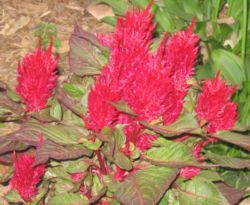Celosia: Difference between revisions
No edit summary |
No edit summary |
||
| Line 1: | Line 1: | ||
{{Inc| | |||
Celosia (Greek, kelos, burned; referring to the burned look of the flowers in some species). Amarantaceae. Cockscomb. Popular garden annuals, grown for the showy agglomerated flower-heads and sometimes for colored foliage. | |||
Alternate-leaved annual herbs, the lvs. entire or sometimes lobed, mostly narrow: fls. in dense terminal and axillary spikes, the spikes in cult, forms becoming densely fascicled and often the sts. much fasciated; perianth very small, 5-parted, dry, the segms. oblong or lanceolate, erect in fr.; stamens 5, the filaments united at base: fr. a circumscissile utricle, with 2 to many seeds.—About 35 species, all tropical, in Asia, Afr. and Amer. | |||
There are two main types of celosias, the crested form and the feathered or plumy ones. The crested cockscomb is very stiff, formal and curious, while the feathered sorts are less so, and are used to some extent in dried bouquets. The plumy sorts are grown abroad for winter decoration, especially under the name of C. pyramidalis, but to a small extent in America. The crested cockscomb is less used as a summer bedding plant than formerly, but it is still commonly exhibited in pots at small fairs, the object being to produce the largest possible crest on the smallest plant. | |||
For garden use, the seeds are sown indoors in early spring, and the plants set out May 1 to 15. If the roots dry out, the leaves are sure to drop off. The cockscomb is a moisture-loving plant, and may be syringed often, especially for the red-spider, which is its greatest enemy. A light, rich soil is needed. | |||
}} | |||
{{Taxobox | {{Taxobox | ||
| color = lightgreen | | color = lightgreen | ||
Revision as of 14:39, 16 June 2009
| Standard Cyclopedia of Horticulture |
|---|
|
Celosia (Greek, kelos, burned; referring to the burned look of the flowers in some species). Amarantaceae. Cockscomb. Popular garden annuals, grown for the showy agglomerated flower-heads and sometimes for colored foliage. Alternate-leaved annual herbs, the lvs. entire or sometimes lobed, mostly narrow: fls. in dense terminal and axillary spikes, the spikes in cult, forms becoming densely fascicled and often the sts. much fasciated; perianth very small, 5-parted, dry, the segms. oblong or lanceolate, erect in fr.; stamens 5, the filaments united at base: fr. a circumscissile utricle, with 2 to many seeds.—About 35 species, all tropical, in Asia, Afr. and Amer. There are two main types of celosias, the crested form and the feathered or plumy ones. The crested cockscomb is very stiff, formal and curious, while the feathered sorts are less so, and are used to some extent in dried bouquets. The plumy sorts are grown abroad for winter decoration, especially under the name of C. pyramidalis, but to a small extent in America. The crested cockscomb is less used as a summer bedding plant than formerly, but it is still commonly exhibited in pots at small fairs, the object being to produce the largest possible crest on the smallest plant. For garden use, the seeds are sown indoors in early spring, and the plants set out May 1 to 15. If the roots dry out, the leaves are sure to drop off. The cockscomb is a moisture-loving plant, and may be syringed often, especially for the red-spider, which is its greatest enemy. A light, rich soil is needed.
The above text is from the Standard Cyclopedia of Horticulture. It may be out of date, but still contains valuable and interesting information which can be incorporated into the remainder of the article. Click on "Collapse" in the header to hide this text. |
| Cockscomb {{{status}}} Fossil range: {{{fossil_range}}}
| ||||||||||||||||||||||||||||||||||||||||||||||||||||||||||||||||||
|---|---|---|---|---|---|---|---|---|---|---|---|---|---|---|---|---|---|---|---|---|---|---|---|---|---|---|---|---|---|---|---|---|---|---|---|---|---|---|---|---|---|---|---|---|---|---|---|---|---|---|---|---|---|---|---|---|---|---|---|---|---|---|---|---|---|---|
 Celosia plumosa | ||||||||||||||||||||||||||||||||||||||||||||||||||||||||||||||||||
| Plant Info | ||||||||||||||||||||||||||||||||||||||||||||||||||||||||||||||||||
| ||||||||||||||||||||||||||||||||||||||||||||||||||||||||||||||||||
| Scientific classification | ||||||||||||||||||||||||||||||||||||||||||||||||||||||||||||||||||
| ||||||||||||||||||||||||||||||||||||||||||||||||||||||||||||||||||
| [[{{{diversity_link}}}|Diversity]] | ||||||||||||||||||||||||||||||||||||||||||||||||||||||||||||||||||
| {{{diversity}}} | ||||||||||||||||||||||||||||||||||||||||||||||||||||||||||||||||||
| Binomial name | ||||||||||||||||||||||||||||||||||||||||||||||||||||||||||||||||||
| {{{binomial}}} | ||||||||||||||||||||||||||||||||||||||||||||||||||||||||||||||||||
| Trinomial name | ||||||||||||||||||||||||||||||||||||||||||||||||||||||||||||||||||
| {{{trinomial}}} | ||||||||||||||||||||||||||||||||||||||||||||||||||||||||||||||||||
| Type Species | ||||||||||||||||||||||||||||||||||||||||||||||||||||||||||||||||||
| {{{type_species}}} | ||||||||||||||||||||||||||||||||||||||||||||||||||||||||||||||||||
| Species | ||||||||||||||||||||||||||||||||||||||||||||||||||||||||||||||||||
| *Celosia argentea | ||||||||||||||||||||||||||||||||||||||||||||||||||||||||||||||||||
| [[Image:{{{range_map}}}|{{{range_map_width}}}|]] | ||||||||||||||||||||||||||||||||||||||||||||||||||||||||||||||||||
| Synonyms | ||||||||||||||||||||||||||||||||||||||||||||||||||||||||||||||||||
| {{{synonyms}}} |
Celosia is a small genus of edible and ornamental plants, similar in appearance and uses to the amaranths. They are sometimes called cockscombs or woolflowers for their brightly colored, woolly flower heads which resemble cockscombs. The name "cockscomb" may be restricted to those whose flower heads are crested by fasciation.
As a food
Celosia argentea var. argentea or Lagos spinach (a.k.a. quail grass, Soko, Celosia, feather cockscomb) is a broadleaf annual leaf vegetable belonging to the Amaranth family (Amaranthaceae). It grows widespread across northern South America, tropical Africa, the West Indies, South, East and Southeast Asia where it is grows as a native or naturalized wildflower, and is cultivated as a nutritious leafy green vegetable. It is traditional fare in countries of Central and West Africa, and is one of the leading leafy green vegetables in Nigeria, where it is known as ‘soko yokoto’, meaning ‘make husbands fat and happy.’[1]
As a grain, Cockscomb is a pseudocereal, not a true cereal.
As a garden plant
Seed production in these species can be very high, 200-700 kg per hectare. One ounce of seed may contain up to 43,000 seeds. One thousand seeds can weigh 1.0-1.5 grams. Depending upon the location and fertility of the soil, blossoms can last 8-10 weeks.
Celosia cristata is a common garden ornamental plant in China and other places.
Images
-
Celosia cristata. Common name Yellow Toreador.
-
Red cockscomb

